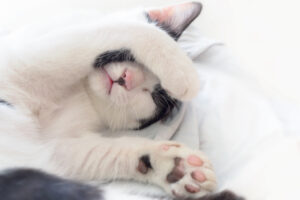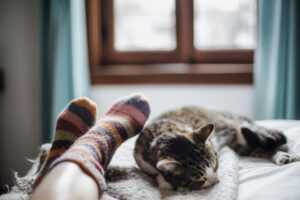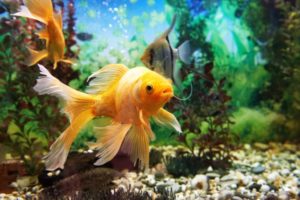How Many Hours Do Cats Sleep?
If you have a cat, you may have noticed that they appear to spend a lot of the day sleeping. Your cat may also be more lively in the early morning or evening hours, perhaps even waking you from your sleep.
Even though your cat’s sleep behaviors might seem unusual compared to yours, they could be completely normal for a cat. Learn more about natural cat sleeping patterns to better understand your cat, recognize when your cat is feeling less than their best, and know when it is time to call your veterinarian.
How Many Hours a Day Do Cats Sleep?
More than half of cats sleep between 12 and 18 hours a day , and nearly 40% of cats sleep more than 18 hours per day. As they grow older, a majority of cats sleep for more hours each day than they did in their younger years.
How Long Do Cats Sleep?
Cats have a polyphasic sleep pattern , which means they sleep multiple times each day rather than in one, long period, like humans generally sleep. These cat naps average 78 minutes in length. However, cats commonly sleep for periods of time ranging from 50 to 113 minutes .
The Sleep Cycle for Cats
Like humans, cats have a circadian rhythm . The circadian rhythm is the internal biological clock that guides the 24-hour sleep-wake schedule.
In humans, the sleep cycle is diurnal, meaning we are naturally prone to stay awake during the day and fall asleep at night. Cats, however, are crepuscular . They experience two peaks of activity, one in the early morning before sunrise and one in the evening around sunset.
Researchers hypothesize that a cat’s crepuscular sleep cycle is driven by their predatory natures. Common prey animals for cats have different sleep cycles. A cat’s crepuscular nature allows it to be awake at daybreak to prey on diurnal birds, and at twilight to prey on nocturnal rodents.
What Happens While Cats Sleep?
Similar to humans, cats cycle through different stages of sleep. Cats experience both non-rapid eye movement (NREM) and rapid eye movement (REM) sleep .
Research shows that cats often experience a period of alertness and activity before becoming drowsy and then falling into NREM sleep. During this NREM stage, your cat may be lightly asleep and ready to awake at a moment’s notice. After NREM sleep, the cat may become alert again and cycle through alertness, drowsiness, and NREM sleep a few times.
Eventually in the cycle, cats transition from NREM to REM sleep. During REM sleep, the eyes move behind closed eyelids. In cats, the eyes can move both horizontally and vertically. You have probably seen your cat experience REM sleep. When cats are in REM sleep, they can twitch or go limp with a loss of muscle tone.
Also, during REM sleep, cats may dream . In humans, dreams most frequently occur during REM sleep . The eye movements made during REM may be linked to dreaming. Researchers have observed cats appearing to act out their dreams while in REM sleep.
Why Do Cats Sleep So Much?
Like humans, cats need to sleep to survive. In humans, consistent sleep allows the body to recharge for the next day. Sleep also plays a part in memory formation and boosting the immune system.
Researchers hypothesize that other mammals, including cats, receive similar benefits. NREM sleep may help the body recharge and conserve energy, while REM sleep can help regulate emotions and other recovery processes. In fact, some mammals, such as rats, lose weight , are unable to regulate body temperature, have weaker immune systems, and eventually die if they cannot sleep.
Should You Be Concerned About Your Cat’s Sleep?
There are a number of natural reasons your cat’s sleep habits may change. For example, if your cat has had a lot of activity for an extended period of time, they may require more sleep than usual. A change of environment, such as a move or addition of a new family member, may impact your cat’s sleep habits. As your cat ages, they also require more sleep.
However, unusual sleep or excessive wakefulness patterns may indicate an underlying health condition. If they are experiencing illness, you may observe other changes in your pet, such as a change in bathroom habits, signs of disorientation, or unusual weight gain or loss.
Excessive Sleep and Lethargy
- Kidney Disease: Cats with kidney disease tend to eat less food, drink more water, sleep more, and be more vocal at night.
- Deafness: Deaf cats sleep more, possibly because their sleep is not as easily disturbed by sound. Other symptoms include increased vocalizations during the day and at night, reduced appetite, and weight loss.
- Hypothyroidism: This thyroid hormone deficiency can appear in juvenile and adult cats . Symptoms include lethargy, hair loss, and decreased appetite.
Restlessness and Decreased Sleep
- Lack of Stimulation: If your cat is overly active, especially at night, they may not be stimulated enough during the day. It may help to play with them regularly. Some people also choose to allow them outside to exercise.
- Hyperthyroidism: Cats with hyperthyroidism have high thyroid hormone levels . Your cat may become excessively excitable. They may also have an increased appetite even though they are losing weight.
- Feline Immunodeficiency Virus (FIV): FIV affects both domestic and wild cats by impairing their immune systems . This disease greatly disturbs sleep patterns, causing cats to have difficulty falling asleep and sleep less overall.
References
17 Sources
-
Sordo, L., Breheny, C., Halls, V., Cotter, A., Tørnqvist-Johnsen, C., Caney, S. M. A., & Gunn-Moore, D. A. (2020). Prevalence of disease and age-related behavioural changes in cats: Past and present. Veterinary Sciences, 7(3), 85.
https://pubmed.ncbi.nlm.nih.gov/32640581/ -
Toth, L. A., Bhargava, P. (2013). Animal models of sleep disorders. Comparative Medicine, 63(2), 91-104.
https://pubmed.ncbi.nlm.nih.gov/23582416/ -
Campbell, S. S., & Tobler, I. (1984). Animal sleep: A review of sleep duration across phylogeny. Neuroscience & Biobehavioral Reviews, 8(3), 269–300.
https://pubmed.ncbi.nlm.nih.gov/6504414/ -
Fujitani, Y., & Hosogai, M. (1983). Circadian rhythm of electrical activity and motility of the stomach in cats and their relation to sleep-wakefulness stages. The Tohoku Journal of Experimental Medicine, 141(3), 275–286.
https://pubmed.ncbi.nlm.nih.gov/6685930/ -
National Institute of General Medical Sciences. (2022, March 11). Circadian rhythms., Retrieved on August 20, 2021 from
https://www.nigms.nih.gov/education/fact-sheets/Pages/circadian-rhythms.aspx -
Parker, M., Lamoureux, S., Challet, E., Deputte, B., Biourge, V., & Serra, J. (2019). Daily rhythms in food intake and locomotor activity in a colony of domestic cats. Animal Biotelemetry, 7(1).
https://link.springer.com/article/10.1186/s40317-019-0188-0#citeas -
Peever, J., & Fuller, P. M. (2017). The biology of REM sleep. Current Biology, 27(22), R1237-R1248.
https://pubmed.ncbi.nlm.nih.gov/29161567/ -
Márquez-Ruiz, J., & Escudero, M. (2008). Tonic and phasic phenomena underlying eye movements during sleep in the cat. The Journal of Physiology, 586(14), 3461–3477.
https://pubmed.ncbi.nlm.nih.gov/18499729/ -
Jouvet, M. (1979). What does a cat dream about? Trends in Neurosciences, 2, 280–282.
https://www.sciencedirect.com/science/article/abs/pii/0166223679901103 -
National Institute of Neurological Disorders and Strokes (NINDS). (2019, August 13). Brain basics: Understanding Sleep., Retrieved August 23, 2021, from
https://www.ninds.nih.gov/health-information/public-education/brain-basics/brain-basics-understanding-sleep -
Cirelli, C., & Tononi, G. (2008). Is sleep essential? PLoS Biology, 6(8), e216.
https://pubmed.ncbi.nlm.nih.gov/18752355/ -
Siegel, J. M. (2005). Clues to the functions of mammalian sleep. Nature, 437(7063), 1264–1271.
https://pubmed.ncbi.nlm.nih.gov/16251951/ -
Purves, D., Augustine, G. J., & Fitzpatrick, D. (Eds.). (2011). Why do humans and many other animals sleep? In Neuroscience (2nd ed.). Sinauer Associates.
https://www.ncbi.nlm.nih.gov/books/NBK11108/ -
Peterson, M. E. (2019, July). Hypothyroidism in animals. Merck Manual Veterinary Manual., Retrieved August 23, 2021, from
https://www.merckvetmanual.com/endocrine-system/the-thyroid-gland/hypothyroidism-in-animals -
Peterson, M. E. (2019, July). Hyperthyroidism in animals. Merck Manual Veterinary Manual., Retrieved August 23, 2021, from
https://www.merckvetmanual.com/endocrine-system/the-thyroid-gland/hyperthyroidism-in-animals -
Tizard, I. (2018, August). Feline immunodeficiency virus (FIV). Merck Manual Veterinary Manual., Retrieved August 23, 2021 from
https://www.merckvetmanual.com/cat-owners/disorders-affecting-multiple-body-systems-of-cats/feline-immunodeficiency-virus-fiv -
Prospéro-García, O., Herold, N., Phillips, T. R., Elder, J. H., Bloom, F. E., & Henriksen, S. J. (1994). Sleep patterns are disturbed in cats infected with feline immunodeficiency virus. Proceedings of the National Academy of Sciences, 91(26), 12947–12951.
https://pubmed.ncbi.nlm.nih.gov/7809152/








